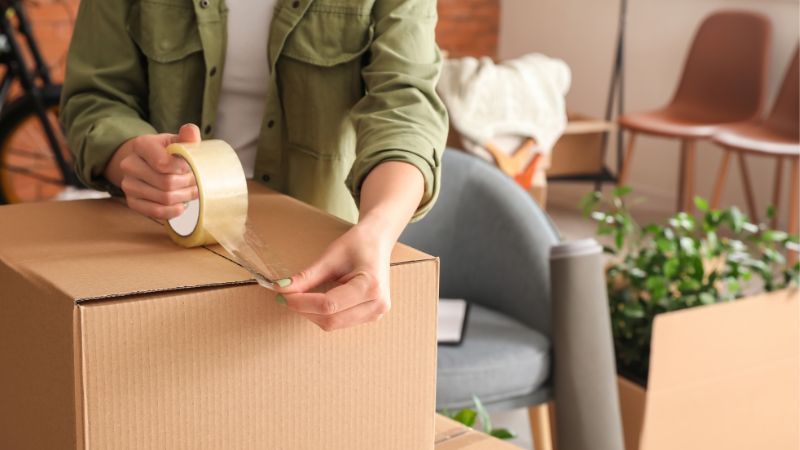Strategic Packing Tips for a Smooth Local Move
Bryan Bloom • May 6, 2024
Moving to a new home, even within the same city, can be a thrilling adventure. However, it doesn't come without its share of challenges, particularly when it comes to packing. With
Kinetic Movers
, York PA's leading full-service moving company, you can breathe a sigh of relief. We're eager to share the nuts and bolts of efficient packing for a local move, ensuring your moving experience is as smooth as possible.

Unpacking the Significance: The Underlying Impact of Efficient Packing
Moving house requires more than simply tossing items into boxes on the eve of the move. An organized and strategic approach to packing keeps stress at bay, protects your valuable possessions, and streamlines the moving process. As York PA's moving professionals specializing in local moves, we channel years of experience, insights, and moving savvy into each packing guide, helping you seamlessly navigate this chapter in your life.Key Elements of your Local Move Roadmap
A well-conceived plan is your greatest asset when aptly subduing the potential chaos of moving. Beginning with an all-inclusive home inventory helps identify and sort items needing special packing and those no longer needed, making room for your new beginnings. As for the packing timeline, it's best to kick start a few weeks in advance, avoiding stress-induced, last-minute rush.Gathering the Arsenal: What You'll Need
Winning the packing war calls for the right weapons. Here's a basic kit to get you started:- Boxes: A variety of sizes are needed to accommodate different items. Remember, heavy items go in small boxes, lighter items in larger ones.
- Protective materials: Bubble wrap and packing paper for fragile items.
- Labels and markers: To stay organized and make your unpacking easier.
Effective Packing Techniques for Space Optimization and Item Safety
The First-Night Box
Moving day fatigue can be a damper, and sifting through boxes for essentials doesn't help. A "first-night" box is your perfect antidote to this situation. Pack it with essentials like toiletries, a change of clothes, medications, and anything you might need immediately upon your arrival.Room-by-Room Packing Strategies
Every room has unique items that demand varied packing strategies:- Kitchen: Wrap fragile items like dishes and glasses individually and use ample cushioning.
- Bedroom: Clothes prefer wardrobe boxes and remember that bedding can double as useful padding.
- Living Room: Remove batteries from electronics to prevent damage and avoid cord chaos with some organization.
- Bathroom: No one wants leaky soap and shampoo. Use sealable plastic bags as an additional layer of protection.
Developing an Efficient System: Effective Labeling and Cataloguing
Labeling your boxes clearly makes unpacking a breeze. Each box's contents and the room it belongs to should be clearly marked on its side. A color-coding system can further improve efficiency - assign each room a color and use corresponding colored labels or markers. This system significantly eases the unpacking process and helps you keep track of all items through an inventory list.Special Considerations for Local Moves
Moving locally comes with its own peculiarities and hiccups. Here's how you can steer clear of these moving pitfalls:- Perishables: Plan your meals ahead of the moving week to avoid wastage. It's best to consume, donate, or dispose of perishable food items and plants, as they don't travel well.
- Pets: A move can disorient your pets. On moving day, create a quiet, comfortable space for them away from the chaos and try to maintain their routine as much as possible.
- Valuables: Items like personal documents, jewelry, or other high-value items should be packed separately and kept with you during the move for extra safety.
Final Preparations and Checkpoints
The day before your moving day is a vital time to run through your checklist and make sure everything is ready for the big shift. With Kinetic Movers at your side, you can rest assured that every detail is taken care of.- Confirm Details With Your Movers: Double-check the arrival time of the moving team and any last-minute details to ensure seamless coordination.
- Prepare Your Appliances and Furniture: Clean and defrost appliances, dismantle furniture, and secure small parts in labeled bags.
- Essential Packing Checklist: Do a quick run-through of your packing checklist to ensure nothing is overlooked.
Ensuring a Seamless Moving Day
The big day is finally here, and it's time to pack up your memories and head to your new home.- Early Start: Be ready for an early start with Kinetic Movers to make the most of daylight hours and beat the peak traffic.
- Loading Tips: If you’re supervising the loading, ensure the heaviest items are loaded first and evenly distributed.
- Final Walkthrough: Conduct a final sweep of your old home, checking every room, closet, drawer, and outdoor areas to ensure nothing gets left behind.
Unpacking in Your New Home: Order and Efficiency
Unpacking your new home might seem like a daunting task. But with a systematic approach, it can be made easy.- Unpacking Strategy: Start with the essentials. The kitchen, bathrooms, and bedrooms should be the first rooms you set up.
- Prioritize Rooms: Focus on the main spaces and gradually move to the other areas of your home.
- Unpacking Tips: Unpack one room at a time to avoid clutter. Breakdown and dispose of boxes as you empty them to keep your new home organized.
Settling into Your New Home
Once the dust of moving settles, it's time to focus on transforming the house into your home.- Decorating and Organizing: In your previous home, you likely had items that just didn't have a place. This is a fresh start; set up your place just how you want it from the very beginning. Think carefully about where you want items and which items you truly want to give space in your new home. Invest in organizational solutions that maximize your space and keep your home tidy.
- Acclimating to a New Neighborhood: Venturing out into your new community can be exciting and slightly anxious. Find your new regular spots, introduce yourself to your neighbors, and soak in the local culture. This transition phase can be made enjoyable if you view it as an exploration adventure.



